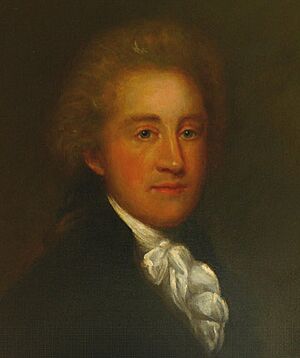Archibald Cochrane, 9th Earl of Dundonald facts for kids
Archibald Cochrane, 9th Earl of Dundonald (born January 1, 1748 – died July 1, 1831) was a Scottish nobleman and a clever inventor. He is best known for finding a new way to make coal tar on a large scale. This invention was very important for ships at the time.
Contents
Archibald Cochrane's Early Life and Challenges
Archibald was the son of Thomas Cochrane, 8th Earl of Dundonald. When he was young, he joined the British Army. Later, he also served in the Royal Navy. In 1778, he returned to Culross after his father passed away. He inherited the title of Earl of Dundonald and some family lands. However, he did not inherit much money. Because of this, Archibald decided to use his mind to invent things and support himself.
How Archibald Invented Coal Tar
Archibald's most famous invention was a way to make coal tar in large amounts. He received a patent for this method in 1781. A company called the British Tar Company invested in his idea. They built a factory to produce the tar. John Loudon McAdam helped manage this company.
The process of making tar also created other useful things. One was coke, which is a type of fuel. An ironworks used some of this coke. Another product was coal gas, which was known to be flammable. However, people at the time did not realize how useful coal gas could be.
Testing Tar for Ships
Archibald hoped to sell his tar to the Royal Navy. They could use it to seal the bottoms of their ships. This would protect the ships from water and sea creatures. He contacted the British Admiralty, which managed the navy. They agreed to test his tar.
A test was done on a buoy. One side of the buoy was covered with Archibald's tar. The other side was left plain. After some time, the plain side of the buoy was leaking. It was also full of worms and barnacles. But the side treated with tar was in very good condition.
Archibald got a patent for his invention. He even used his family's land as a guarantee for the money needed to develop his invention.
Challenges with His Invention
At the time, the Admiralty preferred to use copper sheathing to protect ships. This was another method that competed with Archibald's tar. Some people believe that powerful groups, like shipyards, wanted to keep the business of repairing ships. Copper sheathing needed more repairs than tar.
Eventually, Archibald's patent ran out. After that, the Royal Navy finally started using his tar mixture.
Other Inventions and Financial Struggles
Archibald tried many other experiments. He worked on making alum, which is used in dyeing and tanning. He also tried making bread from potatoes. He even experimented with making paint. Sadly, most of these ideas did not make him money.
He had more success making soda from table salt. But even this was not enough to solve his money problems.
In 1784, Archibald became a member of the Royal Society of Edinburgh. This was a group of important scientists and thinkers. Famous people like James Hutton and Adam Smith supported his membership.
Archibald Cochrane died in Paris when he was 83 years old. He was very poor at the time. His son, Thomas Cochrane, became the next Earl of Dundonald.
Archibald Cochrane's Family Life
Archibald Cochrane was married three times. His first wife was Anne Gilchrist, whom he married in 1774. After she passed away, he married Isabella Mayne in 1788. His third wife was Anna Maria Plowden, whom he married in 1819.
He had four sons:
- Thomas Cochrane: He became the next Earl. He was a very successful officer in the Royal Navy. He also played a key role in the navies of new countries.
- Basil Cochrane: He served briefly in the Royal Navy before joining the British Army.
- William Erskine Cochrane: He also served in the British Army.
- Archibald Cochrane: He served in the Royal Navy.
Experiments with Potatoes
In February 1791, Archibald published a booklet about his experiments. It showed how to make bread using potatoes. By March 1791, he also shared ideas on how to feed poor people. He suggested adding starch and potato powder to flour.
A famous drawing from 1795 made fun of the idea of potato bread. It showed important people avoiding potato bread. Instead, they were eating fancy meals like fish and steaks.
The Cochrane Brothers
Archibald had several younger brothers who also had interesting careers:
- Charles Cochrane (1749-1781): He was a major in the British Army during the American Revolution.
- John Cochrane (1750-1801) and Basil Cochrane (1753-1826): They supplied goods to the British Army and Navy. Basil became very rich by providing supplies to the navy in India.
- Alexander Cochrane (1758-1832): He became an admiral in the navy.
- George (born 1762): He served in the army and in Parliament.
- Andrew (1767-1833): He was an army officer, a governor in a colony, and a member of Parliament.
In 1806, Earl of St. Vincent, a high-ranking admiral, wrote about the Cochrane brothers. He said they were all very adventurous and focused on making money.
| Peerage of Scotland | ||
|---|---|---|
| Preceded by Thomas Cochrane |
Earl of Dundonald 1778–1831 |
Succeeded by Thomas Cochrane |


